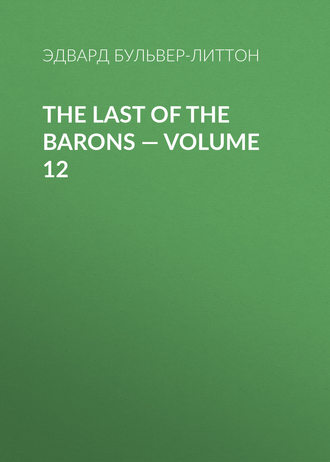
Эдвард Бульвер-Литтон
The Last of the Barons — Volume 12
NOTES
I
The badge of the Bear and Ragged Staff was so celebrated in the fifteenth century, that the following extract from a letter addressed by Mr. Courthope, Rouge Croix, to the author, will no doubt interest the reader, and the author is happy in the opportunity afforded of expressing his acknowledgments for the courteous attention with which Mr. Courthope has honoured his inquiries:—
"COLLEGE OF ARMS. "As regards the badge of Richard Nevile, Earl of Warwick,—namely, the Bear and Staff,—I agree with you, certainly, as to the probability of his having sometimes used the whole badge, and sometimes the Staff only, which accords precisely with the way in which the Bear and Staff are set forth in the Rous Roll to the early earls (Warwick) before the Conquest. We there find them figured with the Staff upon their shields and the Bear at their feet, and the Staff alone is introduced as a quartering upon their shields.
"The story of the origin of these badges is as follows:
"Arth, or Arthgal, is reputed to have been the first Earl of Warwick, and being one of the knights of King Arthur's Round Table, it behooved him to have a cognizance; and Arth or Narth signifying in British the same as Ursus in Latin, he took the Bear for such cognizance. His successor, Morvidus, Earl of Warwick, in single combat, overcame a mighty giant (who had encountered him with a tree pulled up from the root, the boughs of which had been torn from it), and in token of his success assumed the Ragged Staff. You will thus see that the origins of the two were different, which would render the bearing of them separately not unlikely, and you will likewise infer that both came through the Beauchamps. I do not find the Ragged Staff ever attributed to the Neviles before the match with Beauchamp.
"As regards the crest or cognizance of Nevile, the Pied Bull has been the cognizance of that family from a very early time, and the Bull's head, its crest, and both the one and the other may have been used by the king-maker, and by his brother, the Marquis Montagu; the said Bull appears at the feet of Richard Nevile in the Rous Roll, accompanied by the Eagle of Monthermer; the crests on either side of him are those of Montagu and Nevile. Besides these two crests, both of which the Marquis Montagu may have used, he certainly did use the Gryphon, issuant out of a ducal coronet, as this appears alone for his crest, on his garter plate, as a crest for Montagu, he having given the arms of that family precedence over his paternal coat of Nevile; the king- maker, likewise, upon his seal, gives the precedence to Montagu and Monthermer, and they alone appear upon his shield."
II
Hume, Rapin, and Carte, all dismiss the story of Edward's actual imprisonment at Middleham, while Lingard, Sharon Turner, and others, adopt it implicitly. And yet, though Lingard has successfully grappled with some of Hume's objections, he has left others wholly unanswered. Hume states that no such fact is mentioned in Edward's subsequent proclamation against Clarence and Warwick. Lingard answers, after correcting an immaterial error in Hume's dates, "that the proclamation ought not to have mentioned it, because it was confined to the enumeration of offences only committed after the general amnesty in 1469;" and then, surely with some inconsistency, quotes the attainder of Clarence many years afterwards, in which the king enumerates it among his offences, "as jeopardyng the king's royal estate, person, and life, in strait warde, putting him thereby from all his libertye after procuring great commotions." But it is clear that if the amnesty hindered Edward from charging Warwick with this imprisonment only one year after it was granted, it would, a fortiori, hinder him from charging Clarence with it nine years after. Most probable is it that this article of accusation does not refer to any imprisonment, real or supposed, at Middleham, in 1469, but to Clarence's invasion of England in 1470, when Edward's state, person, and life were jeopardized by his narrow escape from the fortified house, where he might fairly be called "in straite warde;" especially as the words, "after procuring great commotions," could not apply to the date of the supposed detention in Middleham, when, instead of procuring commotions, Clarence had helped Warwick to allay them, but do properly apply to his subsequent rebellion in 1470. Finally, Edward's charges against his brother, as Lingard himself has observed elsewhere, are not proofs, and that king never scrupled at any falsehood to serve his turn. Nothing, in short, can be more improbable than this tale of Edward's captivity,—there was no object in it. At the very time it is said to have taken place, Warwick is absolutely engaged in warfare against the king's foes. The moment Edward leaves Middleham, instead of escaping to London, he goes carelessly and openly to York, to judge and execute the very captain of the rebels whom Warwick has subdued, and in the very midst of Warwick's armies! Far from appearing to harbour the natural resentment so vindictive a king must have felt (had so great an indignity been offered to him), almost immediately after he leaves York, he takes the Nevile family into greater power than ever, confers new dignities upon Warwick, and betroths his eldest daughter to Warwick's nephew. On the whole, then, perhaps some such view of the king's visit to Middleham which has been taken in this narrative, may be considered not the least probable compromise of the disputed and contradictory evidence on the subject.







